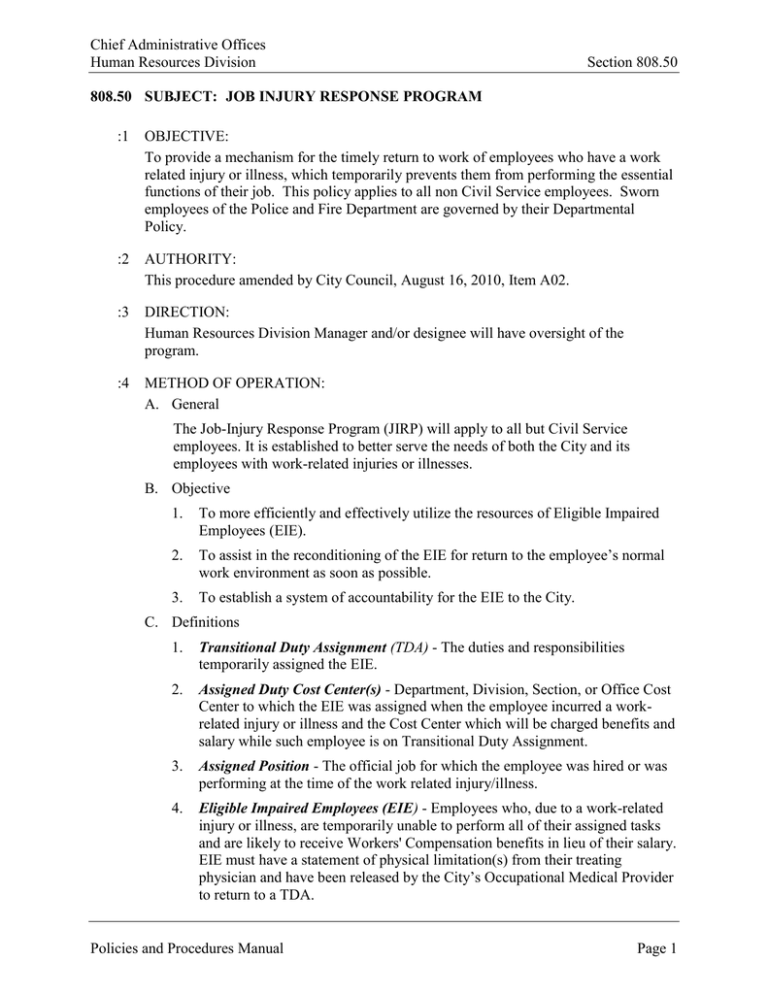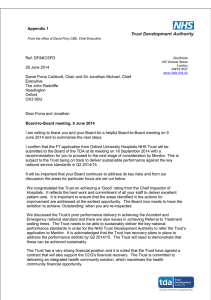Chief Administrative Offices Human Resources Division Section
advertisement

Chief Administrative Offices Human Resources Division Section 808.50 808.50 SUBJECT: JOB INJURY RESPONSE PROGRAM :1 OBJECTIVE: To provide a mechanism for the timely return to work of employees who have a work related injury or illness, which temporarily prevents them from performing the essential functions of their job. This policy applies to all non Civil Service employees. Sworn employees of the Police and Fire Department are governed by their Departmental Policy. :2 AUTHORITY: This procedure amended by City Council, August 16, 2010, Item A02. :3 DIRECTION: Human Resources Division Manager and/or designee will have oversight of the program. :4 METHOD OF OPERATION: A. General The Job-Injury Response Program (JIRP) will apply to all but Civil Service employees. It is established to better serve the needs of both the City and its employees with work-related injuries or illnesses. B. Objective 1. To more efficiently and effectively utilize the resources of Eligible Impaired Employees (EIE). 2. To assist in the reconditioning of the EIE for return to the employee’s normal work environment as soon as possible. 3. To establish a system of accountability for the EIE to the City. C. Definitions 1. Transitional Duty Assignment (TDA) - The duties and responsibilities temporarily assigned the EIE. 2. Assigned Duty Cost Center(s) - Department, Division, Section, or Office Cost Center to which the EIE was assigned when the employee incurred a workrelated injury or illness and the Cost Center which will be charged benefits and salary while such employee is on Transitional Duty Assignment. 3. Assigned Position - The official job for which the employee was hired or was performing at the time of the work related injury/illness. 4. Eligible Impaired Employees (EIE) - Employees who, due to a work-related injury or illness, are temporarily unable to perform all of their assigned tasks and are likely to receive Workers' Compensation benefits in lieu of their salary. EIE must have a statement of physical limitation(s) from their treating physician and have been released by the City’s Occupational Medical Provider to return to a TDA. Policies and Procedures Manual Page 1 Chief Administrative Offices Human Resources Division Section 808.50 5. Job Injury Leave - That time away from the job when an employee has suffered an on-the-job injury/illness and is on Workers' Compensation. It shall be recorded on payroll records as (FMLWC). 6. Work-Related Illness - A sickness contracted by an employee due to an exposure directly related to the performance of assigned duties. 7. Work-Related Injury - A trauma to an employee which occurred while the employee was engaged in the performance of assigned duties. D. Job Injury Response Procedures: 1. Development of Transitional Duty Assignments (TDA) a) Each Department will review its operations to determine what jobs, if any, can be classified for TDA. These assignments should involve useful work and be viewed as opportunities to build motivation to return the EIE to their regular jobs as soon as possible. b) Other Transitional Duty options would be to: 2. (1) Modify normal duties. (2) Seek alternative work within the same Department. (3) Seek other job assignments elsewhere in other City departments. Such assignments to be consistent with collective bargaining agreements if applicable. Employee Placement a) After an employee who has sustained a work-related injury/illness is reclassified as an Eligible Impaired Employee, a work status form shall be prepared by the treating physician stating physical limitations. b) The employee is responsible to immediately return the work status form to his supervisor. c) Should no appropriate work for the impaired employee exist in the employee's Department, the Supervisor will contact the Human Resources Division Manager for possible placement in another department. d) Should the employee be placed in another Department, the employee’s regularly assigned duty cost center will be charged for the employee’s salary and benefits during the TDA. e) 3. In the event there is no TDA available, the employee will be placed on Injury Leave until: (1) Able to perform in his assigned position. (2) Given a TDA. (3) Terminated or placed on Long Term Disability. Time Limitations a) EIE placed in a TDA status shall remain in that status until the employee has: Policies and Procedures Manual Page 2 Chief Administrative Offices Human Resources Division Section 808.50 (1) Been released by the treating physician and the City’s Occupational Medical Provider to report for full duty to the employee's assigned position; or (2) Reached maximum medical improvement and, due to a permanent disability, no longer can perform all the essential functions of assigned position; or (3) Been selected for another full time position; or (4) Exceeded the following time limits: An EIE who is placed on a TDA may remain in the assignment for an initial period not exceeding sixty (60) calendar days. Time granted to perform a TDA need not be consecutive days. Should an employee not be released for full-duty work in his regular assigned position at the end of the initial period, the employee may be granted a maximum of two (2) sixty (60) day extensions depending on the prognosis of the treating physician. An employee who has reached maximum medical improvement and who no longer can perform all the essential functions of an assigned position, or an employee who has exceeded the above time limits, may be terminated. b) An employee who cannot perform the full duties of his assigned position, whether on TDA or Job Injury Leave, and who has accumulated in excess of one hundred eighty (180) days in such status in a continuous twelve (12) month period, whether for a single injury or a combination of injuries, will be required to: a) return to full duty, b) apply for Long Term Disability (LTD) or c) be terminated. A minimum of thirty (30) days prior to the employee reaching the one hundred eighty (180) day maximum, a notice of termination of employment must be sent to the employee from the department where the employee was assigned at the time of the work related injury/illness. The employing department will coordinate with Labor Relations prior to sending the notice of termination. Copies of the notice must be sent to Human Resources, the Worker's Compensation Claims Adjuster and Employee Benefits. During the time period between notice of termination and the effective date of termination, the employee is responsible to contact Human Resources to assist in a "City Wide Job Search" and to contact Benefits to apply for Long Term Disability or retirement. 4. Work Related Injury/Illness-Permanent a) When it is apparent, based upon a medical evaluation, that an employee who has sustained a work-related injury or illness will be unable to fulfill the duties and responsibilities of his/her assigned position due to the nature of the injury/illness and medical prognosis, a notice of termination Policies and Procedures Manual Page 3 Chief Administrative Offices Human Resources Division Section 808.50 may be sent to the employee prior to the time limitations of Section D. 3. of this procedure. b) The employee shall not be considered an EIE due solely to the fact that the injury or illness is permanent. 5. Monitoring The employee’s department is responsible for monitoring the time limits established herein. :5 FORMS: None. :6 COMMITTEE RESPONSIBILITIES: None. :7 REFERENCE: Procedure adopted by City Council May 6, 1991, Item 3/31; amended June 21, 1993, Item 2-P; amended July 17, 2000, Item 3-FF; amended June 2, 2003, Item A6; reformatted only April 2004; amended August 16, 2010, Item A-2. :8 EFFECTIVE DATE: This procedure effective August 16, 2010. Policies and Procedures Manual Page 4
